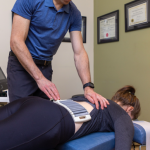Pinched Nerve

Treatments are severity and phase based
Treatments may include Active Release Techniques for scar tissue release and mobility around nerve to release pinched nerve entrapment, Class 3B or 4 laser (penetrates into the soft tissues and nerves to promote healing and reduce inflammation), Chiropractic (at your discretion, with your consent and only if necessary and affecting pinched nerve), and stretching and rehabilitative exercises.
- Nerves need space to slide and travel AND the space to heal (adequate blood flow). Even though nerves are about 2% of your body composition by weight, they require 10-20% of your blood flow/supply.
- If this blood supply is compromised in any way, the nerve will start to complain (pain, tingling, numbness, paresthesia (odd sensations)).
- If time and aggravation of the nerve continue, more serious damage can occur to the nerve and lead to further complications such as muscle weakness and atrophy (and potentially more permanent changes).
- Pinched nerve sensations and pain are often SECONDARY to compressions, restrictions, adhesions (scar tissue) in and around the tendons, fascia or muscles that surround the nerve. This can cause a restricted compartment (carpal tunnel/low back/gluteal region) or ANY area that the nerve has to travel through.
- Temporarily, this tendon/muscle/fascial enlargement or restriction can simply be due to the swelling (‘itis’) of the tendon or other soft tissues surrounding the nerve.
- However, with more persistent, recurrent or chronic versions of a pinched nerve, this swelling is often due to fibrotic material (adhesions) that do not go away even if the swelling subsides.
- These adhesions are tiny forms of scar tissue (collogen haphazardly arranged) that take up space and either compress, restrict or stick to the nerve itself.
- In other words, there are several locations where the nerve may be pinched that are NOT AT THE SITE of the pain or altered sensation.
Nerves do not like to be stretched.
- Therefore, Rehab should include exercises that don’t pull the nerve from both ends. This is often referred to as Nerve Flossing.
- Nerve Flossing includes movements that move the nerve back and forth (like flossing your teeth) between muscles and other soft tissue structures in order to free up the nerve from these entrapments without tugging on the nerve from both ends.
- As well, identifying the aggravating or causational factor is important. This way, we can remove or modify (and/or strengthen and stretch the area) any factors contributing to a recurrence of a pinched nerve.
Similarly, if you experience any of the following symptoms of a pinched nerve contact your clinician URGENTLY:
- Progressive/worsening weakness in legs, arms or torso
- Progressive/worsening of symptoms or pain
- Progressive tingling or numbness
- An inability to pass urine when you feel that you need to go.
- Loss of control of your bowels.
- Numbness around your genital area.